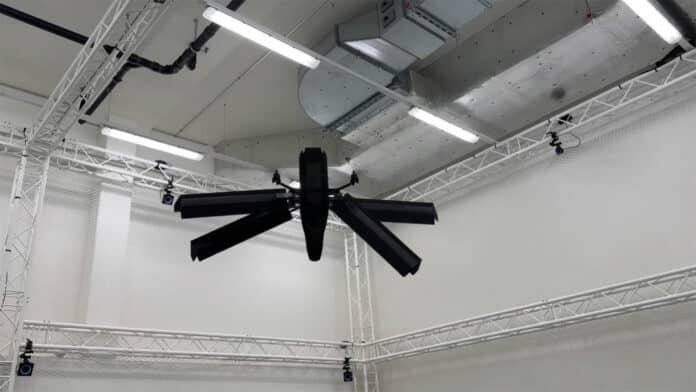Winged aerial robots, commonly referred to as winged drones and drones, are increasingly used in a wide range of professional and non-professional applications today, such as surveillance, reconnaissance, inspection, and search and rescue. However, these flying robots suffer from design limitations that reduce their operational envelope in such environments, increasing cost and restricting their mission advantage over other vehicles.
Now, an EPFL spin-of Elythor has developed a new drone whose wing shape can adapt to wind conditions and flight position in real-time, reducing the drone’s energy consumption. Moreover, the position of the wing can change, allowing the drone to fly vertically or horizontally, making it a perfect candidate for inspecting power plants.
Called Morpho, the new inspection drone features an aerodynamic bullet-shaped body with four quadcopter-style propeller arms and four wings. Its adaptive wings extend the drone’s flight time and give it greater maneuverability. Combined with sensors and cameras, these features let it fly just as well in enclosed spaces as in the open air.
When on the ground, Morpho sits on its four wings angled downwards to hold it upright. The drone’s vertical take-off capability means it can be deployed in confined spaces, fly within just a few centimeters of a piece of equipment, and inspect the equipment without bumping into it.
Once the inspection is completed, Morpho can shift its motors and rotate into a horizontal, more aerodynamic position and swiftly fly off to the next inspection site.
Morpho’s wing control system includes sensors linked to a software program for monitoring wind direction and speed. “The controller automatically selects whether to hold the wings in place or let them move freely with the wind, based on the drone’s trajectory and effective speed, along with any changes in wind direction,” explains Nathan Müller, an Elythor co-founder. “The wings’ surface area can also be adjusted either symmetrically or asymmetrically depending on wind direction.”
The algorithms powering the control system seek to optimize the trade-off between air friction and lift and to minimize power use. This entails taking advantage of wind currents to let the drone glide or adjusting the wings asymmetrically to regulate its yaw – or the rotation around its vertical axis. This provides greater stability in heavy winds.
The EPFL lab tests show that Morpho delivers considerably better maneuverability and power efficiency. “Our design can reduce power use by up to 85% when the drone is flying in the vertical position,” says Müller. “It also significantly improves the drone’s attitude and stability.” These benefits mean Morpho can perform inspections under a broader range of weather conditions.
“Winged drones have the advantage of longer flight times, while quadcopters have better maneuverability,” says Harry Vourtsis, Elythor co-founder and CEO. “We combined the two and added an adaptative wing system that reduces the drone’s power requirement even further.”
Journal reference:
- Charalampos Vourtsis, Victor Casas Rochel, Nathan Samuel Müller, William Stewart, Dario Floreano. Wind-Defiant Morphing Drones. Advanced Intelligent Systems, 2023; DOI: 10.1002/aisy.202200297
- Vourtsis, Charalampos. Resilient drones with morphing wings. DOI: 10.5075/epfl-thesis-9682
- Charalampos Vourtsis, Victor Casas Rochel, Francisco Ramirez Serrano, William Stewart, Dario Floreano. Insect-Inspired Self-Righting for Fixed-Wing Drones. IEEE Robotics and Automation Letters, 2021; DOI: 10.1109/LRA.2021.3096159
